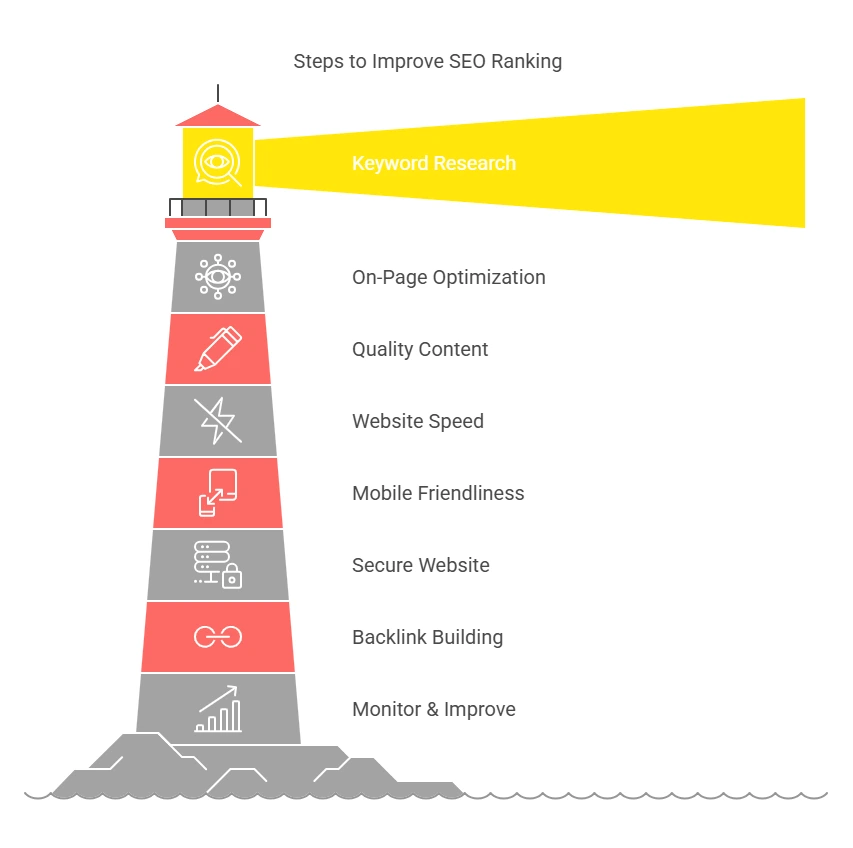Improving your SEO ranking to appear on the first page of search results requires a combination of strategies targeting technical optimization, content quality, and off-page factors. Here’s a step-by-step guide
1. Conduct Keyword Research
- Identify relevant, high-volume, and low-competition keywords using tools like Ahrefs, Semrush, or Google Keyword Planner.
- Focus on long-tail keywords for better targeting and easier ranking.
- Optimize for local SEO by including location-based keywords.

2. Optimize On-Page SEO
- Title Tags & Meta Descriptions: Write clear, compelling titles with your primary keywords. Include a unique meta description for each page.
- Headers: Use H1, H2, H3, etc., to structure your content and naturally include keywords.
- Keyword Placement: Use keywords naturally in the first 100 words, headings, and throughout the content.
- URL Structure: Keep URLs short, descriptive, and keyword-rich.
- Internal Linking: Link related content on your site to help search engines crawl and rank pages better.
3. Publish High-Quality Content
- Focus on user intent and create valuable, well-researched content.
- Write long-form articles (1200–2000+ words) to cover topics comprehensively.
- Update old content regularly to keep it fresh and relevant.
- Use rich media (images, videos, infographics) to increase engagement and dwell time.
4. Improve Website Speed
- Use tools like Google PageSpeed Insights or GTmetrix to test your site speed.
- Compress images using tools like TinyPNG or ShortPixel.
- Enable browser caching and minify CSS, HTML, and JavaScript.
5. Ensure Mobile Friendliness
- Optimize your site for mobile devices using responsive design.
- Test mobile usability with Google’s Mobile-Friendly Test Tool.
- Make navigation simple and intuitive for mobile users.
6. Secure Your Website (HTTPS)
- Use an SSL certificate to switch your site to HTTPS.
- HTTPS is a ranking factor and builds trust with visitors.
7. Build High-Quality Backlinks
- Reach out to authoritative websites in your niche for backlinks.
- Create guest posts or collaborate with bloggers and influencers.
- Use broken link building to find and replace links on other sites with your content.
8. Leverage Local SEO
- Claim your Google Business Profile and optimize it with keywords, business hours, and images.
- Gather positive reviews from satisfied customers.
- Build citations on local directories like Yelp, Bing Places, and others.
9. Focus on Technical SEO
- Create and submit an XML sitemap to Google.
- Fix broken links and eliminate 404 errors.
- Use structured data (schema markup) to enhance search engine understanding and visibility.
10. Enhance User Experience (UX)
- Reduce bounce rates by improving content relevance and website design.
- Make your call-to-action (CTA) clear and compelling.
- Test different layouts and designs using A/B testing tools.
11. Use Social Media for Amplification
- Share your content across social platforms to increase visibility.
- Engage with your audience to drive referral traffic.
12. Monitor and Improve
- Use tools like Google Analytics and Google Search Console to track performance.
- Adjust strategies based on performance data and user behavior.
Pro Tip: Patience is Key
SEO is a long-term strategy. Regularly optimize and monitor your efforts, and you’ll see consistent growth in your rankings.
Would you like specific recommendations for your website or industry?